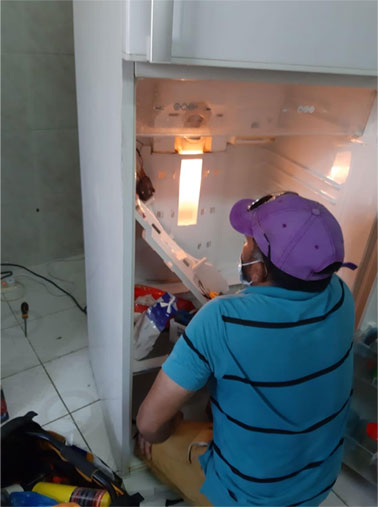|
The worst thing that can happen to a freezer is frost, which is a thick, cold dusting of fine ice that covers everything inside the freezer turning it all into one big solid icy mess. What can cause frost?
Opening it too often and allowing too much warm room temperature air in, which can shut down the freezer elements that are built to process only cold air Blocking air flow by pushing the freezer too close to a wall, which makes the condenser coils act less efficiently
Having a loose rubber seal around the door, which allows that pesky room temperature air in
Basically, in each of these situations, warm air mixes with sub-freezing air. The result is frost. Many newer-model freezers have an automatic frost prevention feature, which regulates temperatures to keep the inside temperature consistently where it needs to be. If you don't have that feature,
here are some other ways to prevent frost:
Keep the door closed – Opening the freezer door allows cold air to escape and introduces humidity. Humidity contains moisture, which can turn into frost. When the temperature inside the freezer rises, the appliance has to work harder to keep items frozen. Avoid unnecessary trips and gather everything you need at once if possible.
Organize it – If you keep your freezer organized, it’s easier for you to find what you need faster, reducing the chances that you’ll have to open and close the freezer multiple times.
Stock it correctly – As a general rule of thumb, freezers should be stocked with two to three pounds of food per cubic foot of space. Frost can build up easily in freezers that are too empty or too full.
Avoid storing hot items – Only put cool or cold foods in your freezer. Storing hot foods can lead to humidity. If you have hot foods that you need to freeze, let them cool off in the refrigerator first.
Dry off food before storing it – By the time you get food from the freezer aisle of your grocery store to your home, it has probably started to defrost a bit, leading to moisture on the outside of the packaging. Before you put these items away, wipe them off with a cloth to remove moisture and prevent frost.
Use the right storage containers – One easy way to avoid frost buildup on your food is to use appropriate storage containers that minimize access to air. If you’re using plastic containers, they should be sized appropriately for the amount of food inside, without a lot of extra room for air. Plastic bags should be freezer or storage bags, which are generally thicker than normal sandwich bags.
Maintain a consistent temperature – Exterior and interior temperatures are key to avoiding frost in your freezer. Keep your freezer inside. Putting your freezer outdoors may mean the appliance has to work harder, especially in colder conditions, which can cause frost. The interior freezer temperature should be around zero degrees Fahrenheit. You can use a freezer thermostat to monitor the temperature.
|
 |
